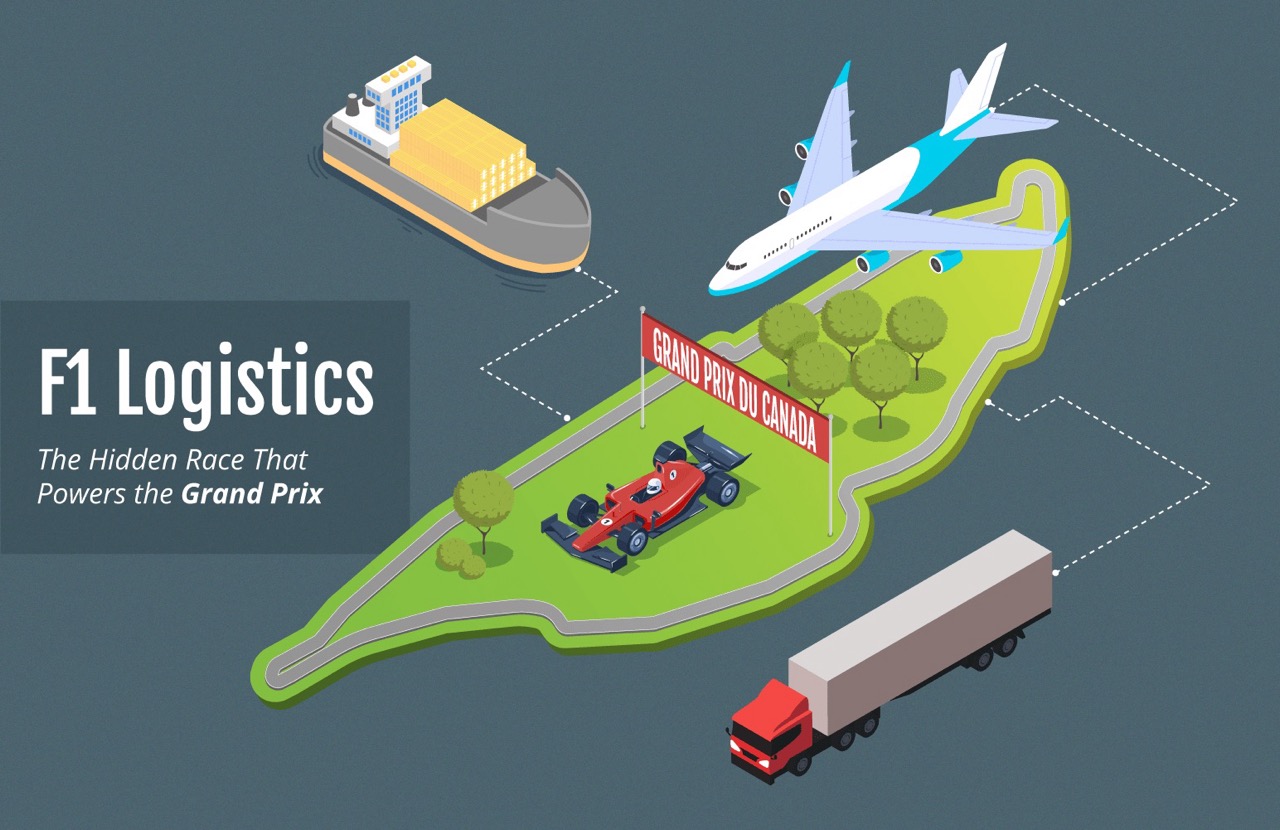
Behind every F1 race is a logistics marathon! Discover the unsung heroes who move cars, gear, and more across the globe at lightning speed.
The F1 team erupts in celebration as their driver takes the win. Engineers and crew cheer, waving flags and embracing. Champagne sprays as mechanics revel under a shower of confetti. The driver, triumphant, stands on the car, saluting the crowd, then ascends the podium to roaring applause as the anthem echoes in a moment of pure victory.
Somebody ought to save a high-five for the logistics team. After all, none of this would be possible without them. As the sport grows in popularity, so does the intensity of the F1 travel schedule. In a sport that features big money, big tech, and small margins of victory, logistics shouldn’t go unrecognized.
The F1 Logistics Schedule is Tight (And Getting Tighter)
Let’s start by looking at the calendar. Formula 1 currently features 10 teams, each fielding two drivers, making a total of 20 cars on the grid. The schedule typically includes around 22 to 24 races each year, running from March to December. The season starts with races in warmer climates, like the Middle East or Australia, and moves through Europe, Asia, and the Americas. Races are held in about 20 different countries, with historic tracks like Monaco, Silverstone, and Spa-Francorchamps alongside newer circuits like Miami and Jeddah. That’s a lot of miles to cover, but what type of freight needs to make the journey?
What Cargo is Transported for F1 Races?
If you’re envisioning race cars traveling as complete units, it’s time to update your perception. These days, the cars are disassembled and reassembled for each race. Some parts are bubble-wrapped to ensure they aren’t damaged in transit.
It’s not just the cars. We’re also talking parts, tools, fuel, oil, tires, broadcast equipment, tents, hospitality equipment, and more.1
The Williams Racing Team alone uses about 60 computer screens at the track, with 400 miles of wiring and cable making it all work.1 Clearly, a herculean effort is required to ensure this mountain of materials makes all the stops on F1’s tight schedule.
Modes of Shipping F1 Cargo
How is all of this gear transported between venues? By land, sea, and air.
Trucks and Kits: With many of the F1 events taking place in Europe, much of the gear is moved by truck. A team’s collective shipment is known as a kit. Kits consist of air containers or pallets. Due to the global nature of the sport, teams have duplicate kits stored around the world.
Ocean Containers: Some of the less urgent equipment, such as furniture or catering items, moves around the planet via ocean containers.
Flyaway Events: When it’s time to dash off to the next continent, much of the gear is sent by air. DHL (F1’s logistics partner) typically uses five Boeing 777s for so-called “flyaway events.”
Late Freight: Sometimes specialized cargo, such as modified car parts, arrives at the track a mere day or two before race day. This late freight has to be expedited, and it’s crucial that it gets there in time.
What Happens When Cargo Doesn’t Reach Its Destination on Time?
Nobody’s perfect. In 2021, the Haas Formula 1 team experienced cargo plane tech troubles.1 The result? A part didn’t reach its destination on time, and the team was forced to miss the first round of pre-season testing in Bahrain. Despite the grueling logistics involved, this is very much the exception, not the rule.
Grand Prix du Montreal Logistics
Let’s take a look at the most recent Grand Prix du Montreal, which occurred in June of 2024. Île Notre-Dame, the small island where the race was hosted, saw goods coming from all over the map.2
F1 had been in Miami the previous month. Some of the equipment that had been used in that race was sent north via trucks, then stored until race day.
After the Miami race, the drivers themselves returned to Europe to compete in several races during the interim. Their cars and other important gear went with them. When it was time to go to Montreal, the gear was sent to team HQ to be sorted and repacked. It then came to Canada via air freight.
Yet more gear arrived in Montreal from Japan. F1 had been there in April for the Japan GP. At the conclusion of that race, freight was sent to Vancouver by ocean, then trucked to Montreal.
Did we mention that Île Notre-Dame is only accessible by two bridges?
The Logistics of Everyday Items
As thrilling as F1 logistics are, let’s not forget the everyday heroes who make sure we get the mundane stuff on time—like groceries, clothes, and that urgent next-day delivery of cat food. Sure, they might not need five Boeing 777s or bubble-wrapped car parts, but the logistics pros behind our everyday lives are just as crucial.
Picture the delivery driver who braves traffic, rain, or wrong addresses, making sure you have your morning coffee beans. Or the warehouse worker who wrangles stock with the precision of a pit stop crew. Let’s give a well-deserved nod to these champions—they keep our world running smoothly, one delivery at a time.
Canadian Alliance is a trusted third party logistics partner. We don’t only offer our clients warehouse space, but also logistics solutions. Contact Canadian Alliance today!
Cited Sources
1 Kulisch, Eric. “The Extreme Logistics behind Formula One’s Global Circus.” FreightWaves, May 31, 2022. https://www.freightwaves.com/news/the-extreme-logistics-behind-formula-ones-global-circus.
2 “A Peek at F1 Logistics in Montreal.” Inside Logisitics, September 27, 2024. https://www.insidelogistics.ca/features/a-peek-at-f1-logistics-in-montreal/.
